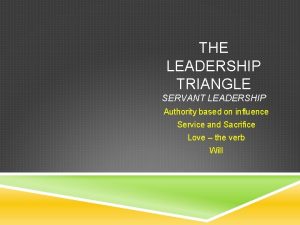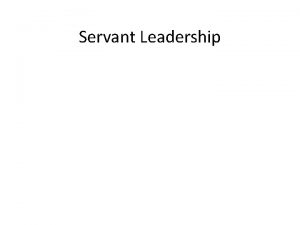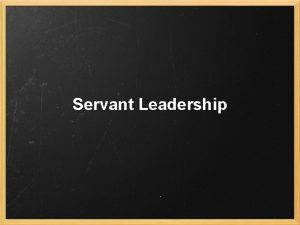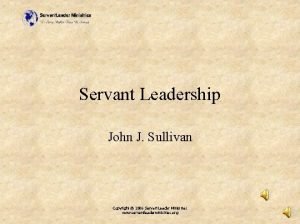Servant Leadership Today we will cover What is











- Slides: 11

Servant Leadership

Today we will cover �What is Servant Leadership �History of Servant Leadership �Characteristics of Servant Leadership � 5 Ways of Being �The Key to Servant Leadership �Reflection & Workshop

What is Servant Leadership? �It is a philosophy and practice of leadership coined in 1904 by Robert K. Greenleaf. �It was never defined by Greenleaf because leadership and service are always in flux. �However, Greenleaf did say that it requires a spiritual understanding of identity, mission, vision and environment. �A servant leader is someone who is servant first, who has responsibility to be in the world, and so he contributes to the well-being of people and community.

What is Servant Leadership �A servant leader looks to the needs of the people and asks himself how he can help them to solve problems and promote personal development. He places his main focus on people, because only content and motivated people are able to reach their targets and to fulfill the set expectations. �“It begins with the natural feeling that one wants to serve, to serve first. Then conscious choice brings one to aspire to lead. That person is sharply different from one who is leader first, perhaps because of the need to assuage an unusual power drive or to acquire material possessions…The leader-first and the servant-first are two extreme types. Between them there are shadings and blends that are part of the infinite variety of human nature. ” Greenleaf, Servant Leadership, 1977.

What is Servant Leadership? �Servant-leaders achieve results for their organizations by giving priority attention to the needs of their colleagues and those they serve. Servant-leaders are often seen as humble stewards of their organization's resources (human, financial and physical). �Servant Leadership is not a concept or a principle. It is an inner standard of living. �Some may suggest that servant leaders are weak. However, nothing could be further from the truth. They model integrity, where their thoughts, words and actions flow from a consistent desire. �Servant leaders are not leaders on the basis of their position or leadership role, but rather lead according to their calling, vision and principles.

History of Servant Leadership �Greenleaf got the idea for Servant Leadership after reading Herman Hesse’s Journey to the East. �Jesus Christ is often referenced as the perfect model of servant leadership. �“Do nothing out of selfish ambition or vain conceit, but in humility consider others better than yourselves. Each of you should look not only to your own interests, but also to the interests of others. Your attitude should be the same as that of Christ Jesus: Who, being in very nature God, did not consider equality with God something to be grasped, but made himself nothing, taking the very nature of a servant, being made in human likeness. And being found in appearance as a man, he humbled himself and became obedient to death-even death on a cross!” Philippians 2: 3 -8

Characteristics of Servant Leadership �Larry Spears, CEO of the Robert K. Greenleaf Center for Servant Leadership has identified 10 characteristics that are central to the development of a servant leader: � 1. Listening – A servant leader is motivated to listen to those around him, including to what is not being said. � 2. Empathy – A servant leader attempts to understand others, and sees them as people who need respect. � 3. Healing - A servant leader tries to help people solving their problems and conflicts in relationships, because he wants to develop the skills of each individual. � 4. Awareness – A servant leader looks to gain general awareness as well as self-awareness. Therefore he has the ability to view the situations from a more holistic view.

Characteristics of Servant Leadership � 5. Persuasion – A servant leader does not use power or influence over others, he tries to convince people. � 6. Conceptualization – A servant leader sees beyond the dayto-day and can focus on long ranging goals. � 7. Foresight – This is ability to foresee the likely outcome of a situation. It enables the servant leader to learn about the past and to achieve a better understanding about the current reality. � 8. Stewardship – The servant leader sees their organization as a way to help and serve others. � 9. Commitment to the growth of people - A servant leader is convinced that people have an intrinsic value beyond their contributions as workers. � 10. Building Community – A servant leader identifies the means to create a true community.

5 Ways of Being �James Autry’s book identified 5 ways of being that will move you toward an unswerving attitude of service: �Be Authentic �Be Vulnerable �Be Accepting �Be Present �Be Useful

The Key to Servant Leadership �The key to Servant Leadership is compassion. �It means compassion for those you are serving and those who are serving with you. �Servant Leadership is a mutually beneficial experience. �Leadership is not an affair of the head, it is an affair of the heart.

Reflection & Workshop �Why is Servant Leadership important? �What is Servant Leadership to me? �How am I practicing Servant Leadership? �How is my chapter practicing Servant Leadership? �How can we improve our Servant Leadership?
 Difference between public servant and civil servant
Difference between public servant and civil servant 12 principles of servant leadership
12 principles of servant leadership Heather gamble
Heather gamble Servant leadership definition
Servant leadership definition Servant leadership webinar
Servant leadership webinar Servant leadership triangle
Servant leadership triangle The servant theories
The servant theories Servant leader definition
Servant leader definition Followership and servant leadership
Followership and servant leadership Servant theories
Servant theories Northouse 2016 transformational leadership
Northouse 2016 transformational leadership Servant leadership vs followership venn diagram
Servant leadership vs followership venn diagram



















